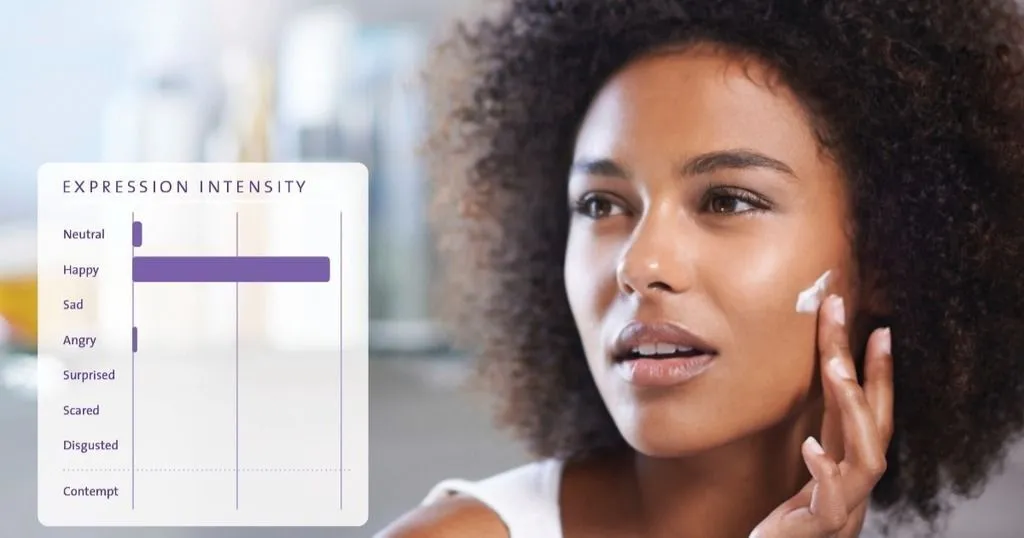Three ways to understand consumer emotions
Many companies are seeking ways to understand consumer emotions in order to predict product acceptability. Here are three ways you could set up your study to assess consumer emotions.
Posted by
Published on
Thu 03 Dec. 2020

Many companies are seeking ways to understand consumer emotions in order to predict product acceptability. Here are three ways you could set up your study to assess consumer emotions.
1. Multi-sensory research
In order to understand consumer emotions, you can use a variety of different technologies. In one recent project, a company claimed to have developed shampoo and hair serum (PIVOINE range, KLORANE) that would have superior relaxing effects. However, they wanted (and according to EU law, needed) proof!
Understanding consumer emotions
Using the Noldus toolkit (which has behavioral metrics along with physiological measurements such as blood pressure, electro-dermal activity, and heart rate) together with the customer, we found out that the relaxing shampoo and serum both had physiological and behavioral effects that pointed to relaxation. The serum had an impact on blood pressure and heart rate, and the shampoo had an impact on EDA and heartbeat intervals.
The relaxing shampoo and serum have been on the market since April 2017, with a claim backed up by scientific data.
Check out the poster about this study for more information!

2. Automatic facial expression analysis
Another way to assess emotions would be to look at the face. Researchers from Mississippi State University and Virginia Tech (USA) explain that the food industry is looking to use implicit measurements to differentiate acceptability of products in the marketplace, and that automated facial expression analysis is a prospective analysis for product acceptability.
Validation of facial expression analysis software
They invited 65 participants to their study and recorded their facial expressions during the experiment. These videos were analyzed frame-by-frame using FaceReader software batch analysis. In this experiment, bitter drinks (distilled water with caffeine) were used to determine and validate automatic facial expression analysis.
The published work shows that a time series analysis is a promising tool for interpreting emotional trends of a population. They explain that time series analysis provided a more holistic picture of the emotional changes and presence over time, and can provide a view of the profile elicited by products.
FREE WHITE PAPER: FaceReader methodology
Download the free FaceReader methodology note to learn more about facial expression analysis theory.
- How FaceReader works
- More about the calibration
- Insight in quality of analysis & output
The role of sensory evaluation
In the video below, Dr. Susan Duncan explains more about another study of hers. In this project the research team aimed to characterize the relationship between emotions, consumer acceptability, and purchase intent towards milk packaging. The facial expression analysis data provided evidence of significant differences in emotion intensity.
3. In-home observations
Nestle Research Center in France aimed to understand consumers’ satisfaction levels while interacting with a packaged food in their homes. Were they happy with their purchase, and what was the greatest factor in determining their satisfaction?
A total of 64 consumers participated in this study. They were willing to buy and try the commercial packaged food chosen in this study. All consumers provided self-recorded videos while interacting with the packaging at home, from the unpacking stage through food preparation.

Coding videos
Researchers from Nestle worked together with Noldus consultants to code behaviors of interest. The analysis showed that specific behaviors occurring during food unpacking and food preparation impacted overall user satisfaction, but explicit questionnaire assessment did not significantly contribute to explain overall satisfaction.
The next step
So, in addition to facial expressions and physiological data, video observations can also give you a wealth of information. Eye tracking is also ideal to follow the gaze of a consumer. It allows you to better answer questions like, “What attracts people’s attention?” and “What is the most convincing product visualization?”
Furthermore, using eye tracking glasses you can also follow consumers in a supermarket or at home to see how they walk through a shop or how they use your product in their own kitchen. By combining different measurement techniques, you can get the best insights into consumer emotions and preference.
FREE TRIAL: Try The Observer XT yourself!
Request a free trial and see for yourself how easy behavioral research can be!
- Work faster
- Reduce costs
- Get better data
References
- Crist, C.A.; Duncan, S.E.; Arnade, E.A.; Leitch, K.A.; O’Keefe, S.F.; Gallagher, D.L. (2018). Automated facial expression analysis for emotional responsivity using an aqueous bitter model. Food Quality and Preference, 68, 349-359. https://doi.org/10.1016/j.foodqual.2018.04.004
- Clark, E.A.; Duncan, S.E.; Hamilton, L.M; Bell, M.A.; Lahne, J.; Gallagher, D.L. & O’Keefe, S.F. (2021). Characterizing consumer emotional response to milk packaging guides packaging material selection. Food Quality and Preference, 87, 103984. https://doi.org/10.1016/j.foodqual.2020.103984
- Labbe, D.; Ferrage, A.; Martin, N. (2014). An implicit behavioral approach to understand user satisfaction while preparing and consuming food at home. In Proceedings of Measuring Behavior 2014, (Wageningen, The Netherlands, August 27- 29, 2014).
Related Posts

Fake or real? AI illusions on the street

Consumer behavior: do we enjoy the buffet to its fullest potential?
